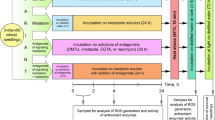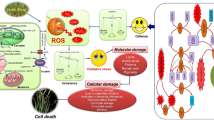Abstract
Peroxisomes, being one of the main organelles where reactive oxygen species (ROS) are both generated and detoxified, have been suggested to be instrumental in redox-mediated plant cell defence against oxidative stress. We studied the involvement of tomato (Lycopersicon esculentum Mill.) leaf peroxisomes in defence response to oxidative stress generated upon Botrytis cinerea Pers. infection. The peroxisomal antioxidant potential expressed as superoxide dismutase (SOD, EC 1.15.1.1), catalase (CAT, EC 1.11.1.6) and glutathione peroxidase (GSH-Px, EC 1.11.1.19) as well as the ascorbate-glutathione (AA-GSH) cycle activities was monitored. The initial infection-induced increase in SOD, CAT and GSH-Px indicating antioxidant defence activation was followed by a progressive inhibition concomitant with disease symptom development. Likewise, the activities of AA-GSH cycle enzymes: ascorbate peroxidase (APX, EC 1.11.1.11), monodehydroascorbate reductase (MDHAR, EC 1.6.5.4), dehydroascorbate reductase (DHAR, EC 1.8.5.1) and glutathione reductase (GR, EC 1.6.4.2) as well as ascorbate and glutathione concentrations and redox ratios were significantly decreased. However, the rate and timing of these events differed. Our results indicate that B. cinerea triggers significant changes in the peroxisomal antioxidant system leading to a collapse of the protective mechanism at advanced stage of infection. These changes appear to be partly the effect of pathogen-promoted leaf senescence.




Similar content being viewed by others
Abbreviations
- AA:
-
Reduced ascorbate
- APX:
-
Ascorbate peroxidase
- CAT:
-
Catalase
- DHA:
-
Dehydroascorbate
- DHAR:
-
Dehydroascorbate reductase
- GR:
-
Glutathione reductase
- GSH:
-
Reduced glutathione
- GSH-Px:
-
Glutathione peroxidase
- GSSG:
-
Oxidised glutathione
- MDHAR:
-
Monodehydroascorbate reductase
- ROS:
-
Reactive oxygen species
- SOD:
-
Superoxide dismutase
References
Arrigoni O, Calabrese G, De Gara L, Bitonti MB, Liso R (1997) Correlation between changes in cell ascorbate and growth of Lupinus albus seedlings. J Plant Physiol 150:302–308
Barroso JB, Corpas FJ, Carreras A, Sandalio LM, Valderrama R, Palma JM, Lupiáñez JA, del Río LA (1999) Localization of nitric-oxide synthase in plant peroxisomes. J Biol Chem 274:36729–36733. DOI 10.1074/jbc.274.51.36729
Beutler E (1975) Glutathione reductase. In: Grune, Stratton (eds) Red cells metabolism, 2nd edn. New York, pp 69–70
Bradbeer JW (1969) The activities of the photosynthetic carbon cycle enzymes of greening bean leaves. New Phytol 68:233–245
Bradford MM (1976) A rapid and sensitive method for the quantification of microgram quantities of protein utilizing the principle of protein-dye binding. Anal Biochem 72:248–254
Brehe JE, Burch HB (1976) Enzymatic assay for glutathione. Anal Biochem 74:315–319
Burgess N, Beakes GW, Thomas DR (1985) Separation of mitochondria from microbodies of Pisum sativum L cv Alaska cotyledons. Planta 166:151–155
Chamnongpol S, Willekens H, Möder W, Langebartels C, Sondermann H, Van Montagu M, Inzé D, Van Camp W (1998) Defense activation and enhanced pathogen tolerance induced by H2O2 in transgenic plants. Proc Natl Acad Sci USA 95:5818–5823
Churin Y, Schilling S, Börner T (1999) A gene encoding glutathione peroxidase homologues in Hordeum vulgare (barley). FEBS Lett 459: 33–38
Clark D, Durner J, Navarre DA, Klessig DF (2000) Nitric oxide inhibition of tobacco catalase and ascorbate peroxidase. Mol Plant Microbe Interact 13:1380–1384
Conklin PL, Pallanca JE, Last Rl, Smirnoff N (1997) L-ascorbic acid metabolism in the ascorbate-deficient Arabidopsis mutant vtc1. Plant Physiol 115:1277–1285
Conrath U, Chen Z, Ricigliano JR, Klessig DF (1995) Two inducers of plant defense responses, 2,6-dichloroisonicotinic acid and salicylic acid, inhibit catalase activity in tobacco. Proc Natl Acad Sci USA 92:7143–7147
Corpas FJ, Sandalio LM, del Río LA, Trelease RN (1998) Copper-zinc superoxide dismutase is a constituent enzyme of the matrix of peroxisomes in the cotyledons of oilseed plants. New Phytol 138:307–314. DOI 10.1046/j.1469-8137.1998.00899x
Corpas FJ, Barroso JB, del Río LA (2001) Peroxisomes as a source of reactive oxygen species and nitric oxide signal molecules in plant cells. Trends Plant Sci 6:145–150
del Río LA, Pastori GM, Palma JM, Sandalio LM, Sevilla F, Corpas FJ, Jiménez A, López-Huertas E, Hernández JA (1998) The activated oxygen role of peroxisomes in senescence. Plant Physiol 116:1195–1200
del Río LA, Corpas FJ, Palma JM, Sandalio LM, Palma JM, Gómez M, Barroso JB (2002) Reactive oxygen species, antioxidant systems and nitric oxide in peroxisomes. J Exp Bot 53:1255–1272
del Río LA, Corpas FJ, Sandalio LM, Palma JM, Palma JM, Barroso JB (2003) Plant peroxisomes, reactive oxygen metabolism and nitric oxide. IUBMB Life 55:71–81. DOI 10.1080/1521654031000094694
Dhindsa RS, Plumb-Dhindsa P, Thorpe TA (1981) Leaf senescence: correlated with increased levels of membrane permeability and lipid peroxidation, and decreased levels of superoxide dismutase and catalase. J Exp Bot 32:91–101
Distefano S, Palma JS, McCarthy I, del Río LA (1999) Proteolytic cleavage of plant proteins by peroxisomal endoproteases from senescent pea leaves. Planta 209:308–313. DOI 10.007/s004250050637
Douce R, Christensen EL, Bonner WD Jr (1972) Preparation of intact plant mitochondria. Biochim Biophys Acta 275:148–160
Eshdat Y, Holland D, Faltin Z, Ben-Hayyim G (1997) Plant glutathione peroxidases. Physiol Plant 100:234–240
Foyer CH, Noctor G (2003) Redox sensing and signalling associated with reactive oxygen in chloroplasts, peroxisomes and mitochondria. Physiol Plant 119:355–364. DOI 10.1034/j.1399-3054.2003.00223.x
Grant JJ, Loake GJ (2000) Role of reactive oxygen intermediates and cognate redox signaling in disease resistance. Plant Physiol 124:21–29
Hatch MD (1978) A simple spectrophotometric assay for fumarate hydratase in crude tissue extracts. Anal Biochem 85:271–275
Hayashi M, Nishimura M (2003) Entering a new era of research on plant peroxisomes. Curr Opin Plant Biol 6:577–582. DOI 10.1016/j.pbi.2003.09.012
Hodges MD, Forney CF (2000) The effects of ethylene, depressed oxygen, and elevated carbon dioxide on antioxidant profiles of senescing spinach leaves. J Exp Bot 51:645–655
Hopkins J, Tudhope GR (1973) Glutathione peroxidase in human red cells in health and disease. Br J Haematol 25:563–575
Hossain MA, Asada K (1984) Purification of dehydroascorbate reductase from spinach and its characterization as a thiol enzyme. Plant Cell Physiol 25:85–92
Igamberdiev AU, Lea PJ (2002) The role of peroxisomes in the integration of metabolism and evolutionary diversity of photosynthetic organisms. Phytochemistry 60:651–674
Jiménez A, Hernández JA, del Río, Sevilla F (1997) Evidence for the presence of the ascorbate-glutathione cycle in mitochondria and peroxisomes of pea leaves. Plant Physiol 114:275–284
Kingston-Smith AH, Foyer CH (2000) Overexpression of Mn-superoxide dismutase in maize leaves leads to increased monodehydroascorbate reductase, dehydroascorbate reductase and glutathione reductase activities. J Exp Bot 51:1867–1877
Knörzer OC, Durner J, Böger P (1996) Alterations in the antioxidative system of suspension-cultured soybean cells (Glycine max) induced by oxidative stress. Physiol Plant 97:388–396
Kuźniak E, Skłodowska M (1999) The effect of Botrytis cinerea infection on ascorbate-glutathione cycle in tomato leaves. Plant Sci 148:69–76
Kuźniak E, Skłodowska M (2001) Ascorbate, glutathione and related enzymes in chloroplasts of tomato leaves infected by Botrytis cinerea. Plant Sci 160:723–731
Kuźniak E, Skłodowska M (2004) The effect of Botrytis cinerea infection on the antioxidant profile of mitochondria from tomato leaves. J Exp Bot 397:605–612. DOI 10.1093/jxb/erh076
Lisenbee CS, Heinze M, Trelease RN (2003) Peroxisomal ascorbate peroxidase resides within a subdomain of rough endoplasmic reticulum in wild-type Arabidopsis cells. Plant Physiol 132:870–882. DOI 10.1104/pp.103.019976
López-Huertas E, Charlton WL, Johnson B, Graham IA, Baker A (2000) Stress induces peroxisome biogenesis genes. EMBO J 19:6770–6777
McCord J, Fridovich I (1969) Superoxide dismutase. An enzymatic function for erythrocuprein (hemocuprein). J Biol Chem 244:6049–6055
Minami M, Yoshikawa H (1979) A simplified assay method of superoxide dismutase activity for clinical use. Clin Chim Acta 92:337–342
Mittova V, Volokita M, Guy M, Tal M (2000) Activities of SOD and the ascorbate-glutathione cycle enzymes in sub-cellular compartments in leaves and roots of the cultivated tomato and its wild salt-tolerant relative Lycopersicon pennellii. Physiol Plant 110:42–51. DOI 10.1034/j.1399-3054.2000.110106.x
Miyagawa Y, Tamoi M, Shigeoka S (2000) Evaluation of defence system in chloroplasts to photooxidative stress caused by paraquat using transgenic tobacco plants expressing catalase from Escherichia coli. Plant Cell Physiol 41:311–320
Morita S, Kaminaka H, Masumura T, Tanaka K (1999) Induction of rice cytosolic ascorbate peroxidase mRNA by oxidative stress; the involvement of hydrogen peroxide in oxidative stress signaling. Plant Cell Physiol 40:417–422
Mullen RT, Trelease RN (1996) Biogenesis and membrane properties of peroxisomes: does the boundary membrane serve and protect? Trends Plant Sci 1:389–394
Nakano Y, Asada K (1981) Hydrogen peroxide is scavenged by ascorbate-specific peroxidase in spinach chloroplasts. Plant Cell Physiol 22:867–880
Neill SJ, Desikan R, Clarke A, Hurst RD, Hancock JT (2002) Hydrogen peroxide and nitric oxide as signalling moleculaes in plants. J Exp Bot 53:1237–1247
Niebel A, Heungens K, Barthels N, Inzée D, Van Montagu M, Gheysen G (1995) Characterization of a pathogen-induced potato catalase and its systemic expression upon nematode and bacterial infection. Mol Plant Microbe Interact 8:371–378
Oksanen E, Häikkiö E, Sober J, Karnosky DF (2003) Ozone-induced H2O2 accumulation in field-grown aspen and birch is linked to foliar ultrastructure and peroxisomal activity. New Phytol 161:791–799. DOI 10.1111/j.1469-8137.2003.00981.x
Palma JM, López-Huertas E, Corpas FJ, Sandalio LM, Gómez M, del Río LA (1998) Peroxisomal manganese superoxide dismutase: purification and properties of the isozyme from pea leaves. Physiol Plant 104:720–726. DOI 10.1034/j.1399-3054.1998.1040429.x
Palma JM, Sandalio LM, Corpas FJ, Romero-Puertas MC, McCarthy I, del Río LA (2002) Plant proteases, protein degradation, and oxidative stress: role of peroxisomes. Plant Physiol Biochem 40:521–530
Pastori GM, del Río LA (1997) Natural senescence of pea leaves: an activated oxygen-mediated function for peroxisomes. Plant Physiol 113:411–418
Patykowski J, Urbanek H (2003) Activity of enzymes related to H2O2 generation and metabolism in leaf apoplastic fraction of tomato leaves infected with Botrytis cinerea. J Phytopathol 151:153–161
Porra JR, Thompson WA, Kiedermann PE (1989) Determination of accurate extinction coefficients and simultaneous equations for assaying chlorophylls a and b extracted with four different solvents: verification of the concentration of chlorophyll standards by atomic absorption spectroscopy. Biochim Biophys Acta 975:384–394
Reumann S (2000) The structural properties of plant peroxisomes and their metabolic significance. Biol Chem 381:639–648
Romero-Puertas MC, McCarthy I, Sandalio LM, Palma JM, Corpas FJ, Gómez M, del Río LA (1999) Cadmium toxicity and oxidative metabolism of pea leaf peroxisomes. Free Rad Res 31:S25–S31
Sandalio LM, Palma JM, del Río LA (1987) Localization of manganese superoxide dismutase in peroxisomes isolated from Pisum sativum L. Plant Sci 51:1–8
Sandalio LM, López-Huertas E, Bueno P, del Río LA (1997) Immunocytochemical localization of copper, zinc superoxide dismutase in peroxisomes from watermelon (Citrullus vulgaris Schrad). Free Rad Res 26:187–194
Schäfer L, Feierabend J (2000) Photoinactivation and protection of glycolate oxidase in vitro and in leaves. Z Naturforsch 55c:361–372
Schwitzguebel J-P, Siegenthaler P-A (1984) Purification of peroxisomes and mitochondria from spinach leaf by Percoll gradient centrifugatuion. Plant Physiol 75:670–674
Verdoucq L, Vignols F, Jacquot J-P, Chartier Y, Meyer Y (1999) In vivo characterization of a thioredoxin h target protein defines a new peroxiredoxin family. J Biol Chem 274:19714–19722
Willekens H, Inzé D, Van Montagu M, van Camp W (1995) Catalases in plants. Mol Breed 1:207–228
Willekens H, Chamnongpol S, Davey M, Schraudner M, Langebartels C, Van Montagu M, Inzé D, Van Camp W (1997) Catalase is a sink for H2O2 and is indispensable for stress defence in C3 plants. EMBO J 16:4806–4816
Wojtaszek P (1997) Oxidative burst: an early plant response to pathogen infection. Biochem J 332:681–692
Wu G, Shortt BJ, Lawrence EB, Levine EB, Fitzsimmons KC, Shah DM (1995) Disease resistance conferred by expression of a gene encoding H2O2-generating glucose oxidase in transgenic plants. Plant Cell 7:1357–1368
Acknowledgements
This work has been partly supported by University of Łódź Grants No 505/429 and 505/430.
Author information
Authors and Affiliations
Corresponding author
Rights and permissions
About this article
Cite this article
Kużniak, E., Skłodowska, M. Fungal pathogen-induced changes in the antioxidant systems of leaf peroxisomes from infected tomato plants. Planta 222, 192–200 (2005). https://doi.org/10.1007/s00425-005-1514-8
Received:
Accepted:
Published:
Issue Date:
DOI: https://doi.org/10.1007/s00425-005-1514-8




